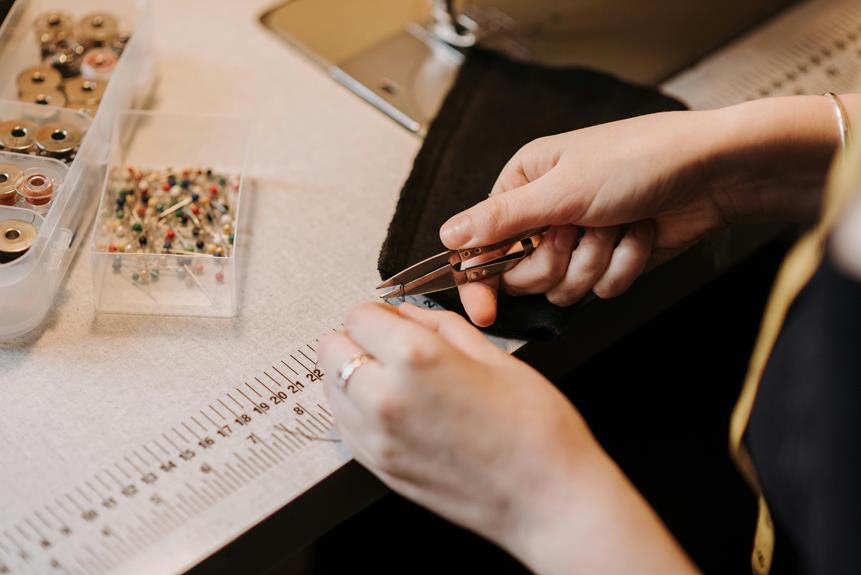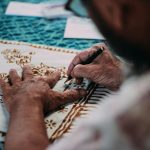When you're ready to cut bias strips for quilting, it's essential to start with well-prepared fabric. You'll want to pre-wash, iron, and trim the selvage edges before identifying the bias grain. Once you've marked a 45-degree angle, the real precision work begins. Using the right tools, like a rotary cutter and a clear ruler, can make a significant difference in ensuring your strips are uniform. But there are a few key tips that can help you achieve even more accuracy and efficiency in your cutting process, which can transform the way your quilting project turns out.
Table of Contents
Key Takeaways
- Bias strips are cut on the diagonal for flexibility, making them ideal for binding quilts and avoiding puckering.
- Ensure fabric is pre-washed, ironed, and squared before cutting to achieve clean, accurate edges.
- Fold fabric to align selvage edges, creating a triangle to easily identify the bias grain at a 45-degree angle.
- Use a rotary cutter and ruler for precise cuts, measuring strip widths typically between 1 to 2 inches for consistency.
Understanding Bias Strips
Bias strips are fabric pieces cut on the diagonal, allowing them to stretch and curve easily, making them perfect for binding quilts or adding decorative edges. When you cut fabric on the bias, you tap into the fabric's inherent flexibility, which helps your finished project maintain its shape and drape beautifully. This flexibility is especially useful when you're working with curves or rounded corners, ensuring that your binding lays flat without puckering.
Understanding bias can enhance your quilting skills significantly. The two main types of bias cuts are straight bias and crosswise bias. Straight bias runs parallel to the selvage, while crosswise bias runs perpendicular to it. Each type has its own uses, but crosswise bias is commonly preferred for binding due to its superior stretch.
When you choose fabrics for bias strips, consider their weight and weave. Fabrics like cotton or cotton blends work well, while heavier fabrics might be too stiff. Always remember to cut your strips consistently to keep your projects looking professional.
Tools Needed for Cutting
To achieve clean and accurate cuts for your quilting projects, you'll need a few essential tools. Having the right equipment makes all the difference, ensuring your bias strips are perfect for sewing. Here's what you should gather before you start:
- Rotary Cutter: This tool allows for smooth, precise cuts through multiple layers of fabric. It's essential for cutting bias strips efficiently.
- Self-Healing Mat: A self-healing cutting mat protects your surfaces and prolongs the life of your rotary cutter. Look for one with measurement grids to help guide your cuts.
- Ruler: A clear acrylic ruler with grid lines is crucial for measuring and aligning your fabric accurately. It gives you confidence in your cutting dimensions.
- Fabric Scissors: While a rotary cutter is your go-to, a sharp pair of fabric scissors is handy for trimming threads or making small adjustments.
Preparing Your Fabric
Before cutting your bias strips, it's important to prepare your fabric properly to ensure clean and accurate results.
Start by washing your fabric if it's new. This removes any sizing and potential shrinkage later on. After washing, dry it completely, either by air or in the dryer, depending on the fabric type.
Next, iron your fabric to eliminate any wrinkles. Make sure to press rather than drag your iron to avoid stretching the fabric. Lay the fabric on a flat surface, ensuring it's smooth and free from creases. If your fabric has a selvedge edge, trim it off to create a clean working edge.
Once your fabric is ready, it's time to square it up. Fold the fabric in half so the selvages align, and then cut along the fold to create two equal pieces. After that, check for any uneven edges and trim them if necessary. This step is crucial for accuracy when cutting your bias strips.
With your fabric prepared, you're now set to find the bias grain and start cutting strips with confidence!
Finding the Bias Grain
Locating the bias grain in your fabric is essential for accurately cutting strips that will stretch and curve beautifully in your quilting projects. The bias runs diagonally across the fabric, allowing for that desirable flexibility. Here's how to find it:
- Identify the Selvage Edges: Start by locating the selvage edges, which are the finished edges of the fabric that don't fray.
- Fold the Fabric: Bring the two selvage edges together so they meet, forming a triangle at the top. This triangle indicates the bias.
- Visualize the 45-Degree Angle: The bias runs at a 45-degree angle to the selvage. Picture an imaginary line bisecting the triangle; this is your bias line.
- Mark the Bias Line: Use a fabric marker or tailor's chalk to draw a line along this bias edge. This will serve as your guide for cutting accurate strips.
Now that you've found the bias grain, you're ready to cut those strips with confidence.
Remember, cutting along the bias will give your quilt a beautiful drape and dynamic look.
Happy quilting!
Measuring and Marking
To get started with measuring and marking, you'll need some essential tools at hand.
Accurate measurements matter when cutting bias strips, so pay close attention to your markings.
Let's explore the various marking techniques that can help you achieve precise results.
Tools You Will Need
Gathering the right measuring and marking tools is essential for achieving precise bias strips in your quilting project. With the right tools at hand, you'll make accurate cuts and ensure your strips are consistent. Here's what you'll need:
- Quilting ruler: A clear acrylic ruler allows you to see your fabric beneath, ensuring accurate measurements. Look for one with both inch and metric markings for versatility.
- Rotary cutter: This sharp tool slices through fabric effortlessly. It's perfect for cutting long strips without the hassle of scissors.
- Cutting mat: A self-healing cutting mat protects your work surface and provides a grid for easy measuring. Choose a mat that's large enough to accommodate your fabric pieces.
- Fabric marker or chalk: Use a fabric marker or chalk to draw straight lines on your fabric. Make sure it's suitable for your fabric type and easy to wash out after you're done.
Having these tools will streamline your process, allowing you to focus on what you love most—creating beautiful quilts!
Get ready to dive into cutting those bias strips with confidence.
Accurate Measurements Matter
Ensuring accurate measurements is crucial for cutting bias strips that fit perfectly into your quilting design.
Start by gathering your fabric and laying it flat on a cutting mat. Use a clear ruler to measure the width of the strips you want to cut. Remember, bias strips are typically cut at a 45-degree angle, which means you'll need to measure and mark carefully.
When you measure, double-check your numbers. It's easy to misread a ruler, especially if you're working with thicker fabric. If you're cutting multiple strips of the same size, it's a good idea to measure once, mark all the lines, and then cut. This will save you time and help ensure consistency.
Use the straight edges of the fabric as your guide, and always align your ruler carefully before making any cuts. If you notice any discrepancies in your measurements, take the time to correct them before you proceed.
Marking Techniques Explained
Effective marking techniques are essential for achieving precise cuts when creating bias strips for quilting. When you take the time to measure and mark accurately, you'll ensure that your strips are uniform and easy to work with.
Here are some techniques to help you get started:
- Use a rotary cutter and mat: This combination allows for smooth, straight cuts. Position your fabric on the mat, aligning the edges with the grid lines for accuracy.
- Mark with a ruler: Instead of eyeballing it, use a clear ruler to measure the width of your bias strips. Mark the fabric with a fabric pencil or chalk for easy visibility.
- Draw cutting lines: After marking the strip widths, draw clear, straight lines across your fabric. This will guide your cuts and help maintain precision.
- Pin along the edges: If you're cutting multiple strips, pinning the edges can keep everything secure and aligned as you work.
Cutting the Bias Strips
To cut bias strips accurately, lay your fabric flat on a cutting mat and identify the grain lines. The bias runs diagonally across the fabric, so you'll want to position your fabric accordingly.
Once you've found the diagonal, use a ruler to measure the width of the strips you need, usually between 1 to 2 inches for most quilting projects.
Grab your rotary cutter and place your ruler along the marked line, ensuring it's stable. Press down firmly on the cutter and glide it along the edge of the ruler to create a clean cut.
Repeat this process, moving down the fabric, until you've cut the desired number of strips. Be mindful of your fingers and always cut away from your body for safety.
If your strips are longer than your fabric piece, you can join them later. After cutting, stack your strips neatly, keeping them organized to avoid any tangles.
This method ensures each strip maintains the necessary stretch and drape for effective piecing. With your bias strips ready, you're one step closer to creating your beautiful quilt!
Tips for Accurate Cutting
Accurate cutting is crucial for achieving precise quilt pieces, so always double-check your measurements before making any cuts. Here are some tips to ensure you're cutting accurately every time:
- Use a Rotary Cutter: A sharp rotary cutter glides through fabric smoothly, providing clean edges that scissors can't match.
- Straighten Your Fabric: Before cutting, make sure your fabric is laid out flat and straightened. This prevents any slippage that could lead to uneven strips.
- Measure Twice: Always measure your fabric twice before cutting. This simple step can save you from costly mistakes and wasted material.
- Utilize a Cutting Mat: A cutting mat with grid lines helps you align your fabric accurately. Use the lines to guide your cuts, ensuring they're straight and even.
Frequently Asked Questions
Can I Use Any Type of Fabric for Bias Strips?
Yes, you can use various types of fabric for bias strips. Just make sure the material's flexible enough to work with curves. Cotton, linen, and some blends are great choices for achieving the desired effect.
How Do I Store Leftover Bias Strips?
To store leftover bias strips, fold them neatly and place them in a dedicated container or bag. Label it to easily identify the fabric later. Keep it in a cool, dry place to prevent damage.
What Are Common Mistakes to Avoid When Cutting Bias Strips?
When cutting bias strips, avoid using dull blades, skimping on measurements, and rushing the process. Make sure you're working on a flat surface and double-check your angles to ensure accuracy and prevent frustrating mistakes.
Can I Cut Bias Strips Without a Rotary Cutter?
Yes, you can cut bias strips without a rotary cutter. Just use sharp fabric scissors for clean edges. Make sure to measure accurately and cut slowly to ensure you maintain the correct angle and width.
How Do I Join Bias Strips Together Effectively?
To join bias strips effectively, align the strips at a right angle, right sides together. Stitch diagonally from one corner to the other, then trim excess fabric. Press the seam open for a flat finish.
- Tetron Fabric for Marine Applications: Durability and Use Cases - June 18, 2025
- Tetron Fabric for Outdoor Furniture: Weather Resistance and Care - June 18, 2025
- Tetron Fabric for Wall Coverings: Style and Application Tips - June 18, 2025



